Costa Rica
Tour and Panama Cruise with CruiseWest
The Indigenous Emberá
People of Panama * Photos
and text by Jack
Yeazel
Return
to Home Page
GENERAL:
Europeans first discovered the region in 1501, and Christopher Columbus
sighted Emberá on his fourth voyage in 1503. The Spanish established
the first European colony in South America, Santa María la Antigua
del Darién, in Darién in 1510. From the town of Vasco,
Núñez de Balboa made his march to the Pacific in 1513.
Some of the refugees from Santa María went on to found Panama City
in 1519.
Emberá Province was formed in 1922 from the Panama Province
in eastern Panama consisting mostly of jungle and sparsely populated areas.
To this day there is no road through the dense Darién jungle to
connect Panama with neighboring Colombia. The Emberá and Wounaan
Indians of Panama there are accomplished artisans and produce elaborate
and detailed tagus carvings from seeds of the Tagua tree. These gentle
and timid people look and dress as they did when Columbus arrived in the
1500s. Emberá Territory, was created in 1998 from a portion
of Darién Province
We swung our legs over the edge of the rubber boats, lowered ourselves
into the shallow surf, and waded to the beach not far from the Emberá's
thatched native buildings -- a typical "wet" landing. Inside the
huts, young women with layers of colorful necklaces (partly) covering their
breasts were weaving baskets. The men gathered in the largest palapa
(the community building) to prepare for some festive music and dancing
to celebrate our arrival. The February climate is quite pleasant
due to the cold Humboldt Current that moderates the coastline temperatures.
The Emberá lifestyle is primitive but remarkably easy for
a forest-bound people. Before the Panamanian government declared
the Rio Chagres area a national park, the subsistence-level Emberá
hunted and farmed and struggled for their rights to continue to live in
their customary peaceful lifestyle. These people are generally quite
small and sinewy, but the younger generation will, in time, most likely
add an inch or two to the tribe's overall average height. With the
National Park Declaration, they had to find an alternative life style.
The Emberá instead had a Renaissance. They went into business
to sell, well, ...themselves!

Click on the following
thumbnails for larger views
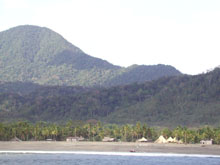 .....
.....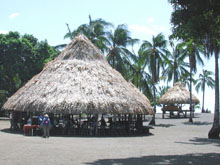 .....
.....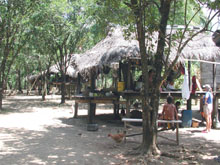
-
The village lies at the foot of a small
mountain range.
-
The main palapa and meeting room.
-
Its people live in a collection of neat
thatched huts on stilts to protect them from the tides.
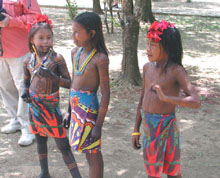 .....
..... .....
.....
-
First we meet some of their beautiful children
-all dressed up for company!
-
Naturalist Rudy Zamora talks to some mothers
with their babies -watched over by the chief.
-
The men tune up their native instruments
for a festive dance prepared for their guests.
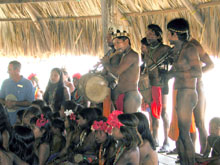 ......
...... .....
.....
-
These fellows make pretty good music.
-
The children dance to the beat of
a drum played by a young girl.
-
And around they go in varied dance
patterns.
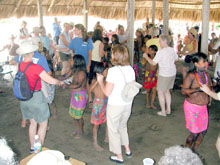 .....
.....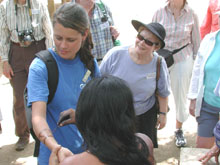 .....
.....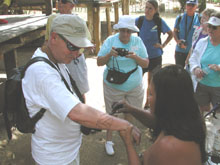
-
Eventually the guests are invited to dance
with the children.
-
Programs Coordinator, Karine Rosvold, gets
"tattooed" with the Emberá's concoction of herbal paint.
-
Now Gary Ratzlaff wants to try it out!
It takes several days for the paint to wear off.
 .....
.....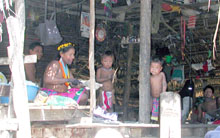 .....
.....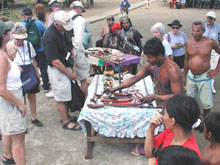
-
Here a man demonstrates how he makes his
waterproof bowls from reeds.
-
A typical family dwelling.
-
At the end of the visit, the natives bring
out their wares to sell.
An interesting characteristic of these people is that they won't accept
money as gifts. The Panamanian Government, therefore, gave them a
sidewalk! The Pacific Explorer crew collects donations from the guests,
finds out what the Emberá would find useful, such as school books
to learn Spanish, and buys it for them. The natives speak their own
language dating back at least 500 years and have to LEARN Spanish, since
it's not their native language.

 .....
..... .....
.....

 .....
..... .....
.....